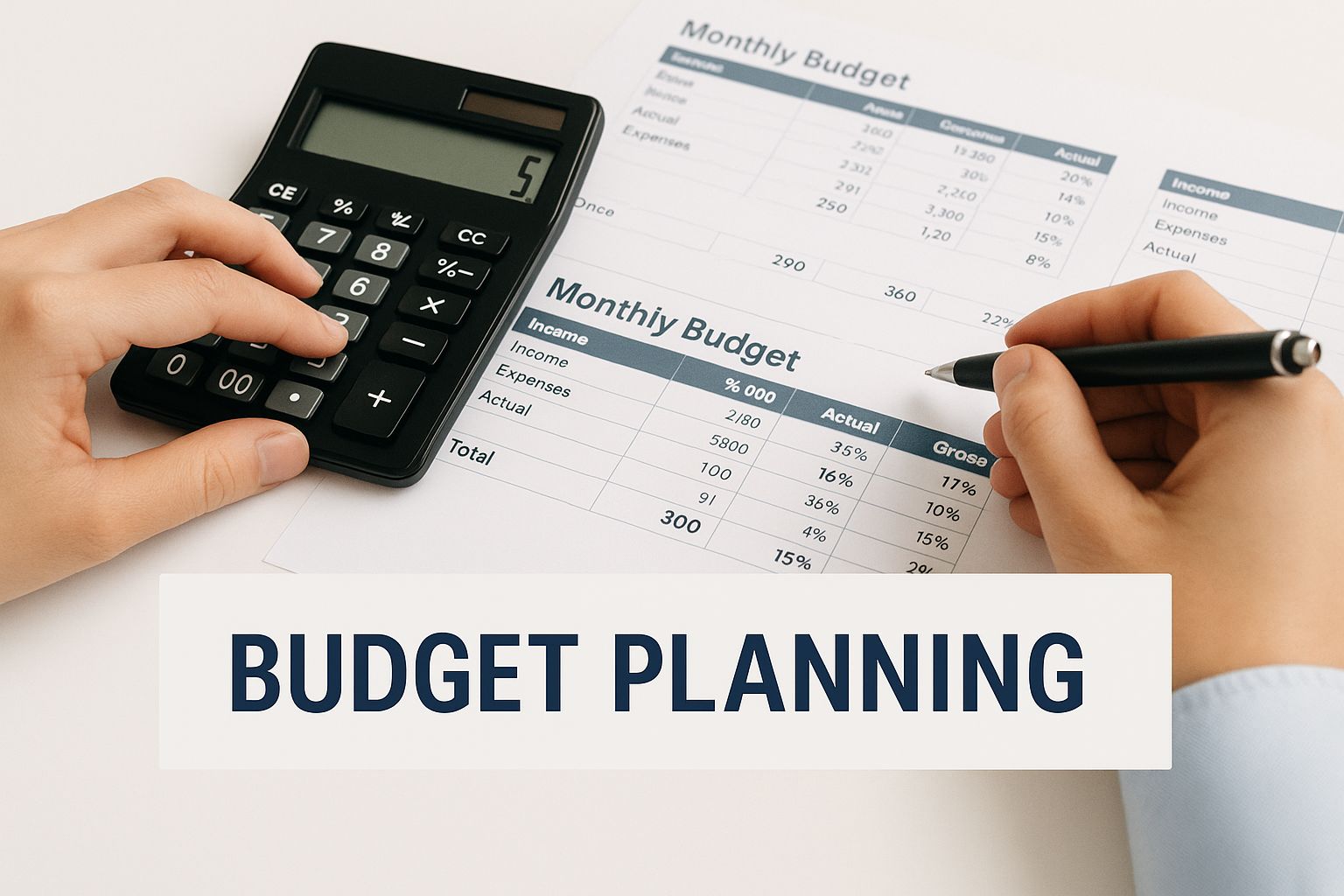
Think of your grant application form template as the front door to your funding opportunity. It’s so much more than a simple document for gathering information. A clear, thoughtful form can attract the high-quality applicants you’re looking for, while a confusing or clunky one might turn away the very changemakers you want to fund.
Why Your Grant Application Form Is Crucial for Success

In the competitive world of grant funding, your application is the first—and often most critical—point of contact. It’s essentially the interview before the interview. This is your chance to show off your organization's professionalism and clearly communicate your program's priorities. A well-constructed form sets a positive, respectful tone and signals that you value your applicants' time and effort.
On the flip side, a poorly designed form creates friction right from the start. If applicants are wrestling with vague questions, a confusing layout, or frustrating file upload requirements, they might just give up. This means you could be missing out on incredible, groundbreaking projects simply because the first step was a hurdle. A great grant application form template isn't a barrier; it's a guide that leads applicants smoothly through the process.
Signaling Professionalism and Purpose
A clean, logical, and easy-to-follow application form immediately establishes your credibility. It demonstrates that your organization is organized, detail-oriented, and serious about its mission. This professional presentation encourages applicants to put their best foot forward, confident that their proposal will be reviewed within a fair and well-structured system.
This first impression matters more than you might think. The grant world is incredibly competitive. To put it in perspective, the National Institutes of Health (NIH) reported a grant success rate of just 21% in 2020, funding only 11,035 out of 54,903 research applications. With competition that fierce, a clear and professional application process is non-negotiable if you want to attract top-tier proposals. You can explore more grant statistics and trends to get a better sense of the landscape.
Filtering for the Right Fit
A strategic grant application form is also a powerful filtering tool. When you ask targeted questions that tie directly back to your funding priorities, you naturally screen for the most relevant and qualified candidates. This ensures your review team invests its valuable time evaluating proposals that genuinely align with your goals.
A well-crafted application doesn't just collect data; it guides applicants to demonstrate their alignment with your mission. It helps you find the signal in the noise, ensuring your resources are directed toward projects with the highest potential for impact.
This strategic approach benefits everyone. Applicants can quickly self-assess if they're a good fit, saving them from pouring hours into an application that's not right for them. For your team, it means a stronger, more relevant pool of submissions, which makes the entire review and decision-making process more efficient. Ultimately, a better form leads to better data, empowering you to make more informed and impactful funding choices.
The Anatomy of a High-Impact Grant Application Form
Let's break down what separates a decent grant application form from a truly effective one. Think of it like a blueprint for a house. A messy, confusing blueprint leads to a shaky foundation and a frustrating build. Likewise, a disorganized form results in incomplete data and annoyed applicants, while a well-designed one gathers exactly what you need for a fair and efficient evaluation.
Each section of your application form is like a different room in that house. Each has its own purpose, but they all need to connect logically to create a cohesive whole. The goal is to build a comprehensive form that collects all the necessary information without ever feeling overwhelming to the person on the other side of the screen.
Here’s a look at the essential "rooms" you need to build into your grant application form template.
Foundational Applicant Information
This is the front door, the entryway of your application. It’s where you gather the basic, non-negotiable details required for initial eligibility checks and future communication. This section isn't just about getting a phone number; it's your first step in verifying the applicant's identity and legal standing.
You absolutely need to ask for:
- Organization Details: The official name, address, website, and, crucially, the Employer Identification Number (EIN) for nonprofits.
- Primary Contact: The name, title, email, and phone number for the key person managing the application.
- Mission and History: A short summary of what the organization does, how it started, and its major wins. This brief intro sets the stage for everything that follows.
This initial data is the bedrock of the entire application. Without it, you can't confirm an organization's 501(c)(3) status or even get in touch with them for follow-up questions. It’s a simple, but critical, first step.
The Narrative-Driven Project Proposal
If the applicant info is the entryway, the project proposal is the main living area—it's where the real story comes to life. This is the heart and soul of the application. It’s the applicant's chance to explain the what, why, and how behind their work. Your job is to ask questions that draw out a clear, compelling narrative.
A strong proposal is best broken down into smaller, more manageable parts:
- Statement of Need: What specific problem is this project trying to solve? Nudge applicants to back up their claims with real data and stories from the community they serve.
- Project Description and Goals: So, what's the plan? Here, applicants should lay out the project's activities, what they aim to achieve, and what the outcomes will look like.
- Timeline and Key Activities: A clear timeline isn't just a list of dates; it shows your team they've thought through the process and have a realistic plan. It sets clear expectations for hitting key milestones.
- Evaluation and Success Metrics: How will anyone know if this project was a success? This is all about accountability. Asking for specific metrics forces applicants to think about tangible results from day one.
A project proposal should do more than just list activities; it should tell a story of impact. The best applications connect a clearly defined problem to a logical solution and provide a realistic roadmap for achieving measurable change.
The Critical Budget Breakdown
The budget section is where big ideas meet financial reality. Just asking for a total funding amount isn't nearly enough. A detailed, line-item budget gives you a window into the project's feasibility and the organization's financial health. Frankly, it’s one of the most revealing parts of any grant application.
A well-planned budget isn't just a spreadsheet; it's a sign of a well-planned project.

This gives your reviewers confidence that the applicant can manage funds responsibly. You can see how this financial piece fits into the larger puzzle by exploring some grant management best practices. A detailed budget ensures every dollar requested is justified and tied directly to project activities—from salaries and supplies to overhead costs. This transparency is what empowers your team to make funding decisions with confidence.
Designing a User-Friendly Application Experience

A great grant application isn't just about the questions you ask—it's about how you ask them. Think of it like this: if you walk into a store and can't find what you're looking for, you’ll probably just leave. The same goes for your application form. A confusing, clunky, or disorganized experience will frustrate applicants, and you'll miss out on incredible proposals.
When you design a form that people can navigate with confidence, you're doing more than just collecting data. You're creating an environment where an applicant's vision can shine, free from administrative headaches. Shifting your mindset from a simple data-collection tool to a user-focused experience is the first step toward attracting top-tier submissions.
Establish a Logical and Intuitive Flow
Your form should feel like a conversation, guiding applicants naturally from one section to the next. Kick things off with the easy stuff, like basic contact and organizational details. Once they're warmed up, you can move into the heavier lifts like the project narrative and budget breakdown. This gradual build-up helps prevent that deer-in-the-headlights feeling that can stop a great application in its tracks.
A classic mistake is to front-load the most demanding questions. Imagine being asked for a detailed five-year impact projection before you’ve even typed in your organization's name. It's jarring. A smooth, intuitive flow respects the applicant’s time and thought process, making the entire journey less of a chore.
A well-designed form acts like a helpful guide, leading applicants step-by-step through the process. The less mental energy they spend trying to figure out your form, the more they can invest in crafting a compelling proposal.
This isn’t just about being nice to your applicants; it makes your life easier, too. When information is organized logically, your team can review and compare submissions fairly and efficiently. This consistency is a cornerstone of an effective application review process.
Use Clear Language and Helpful Instructions
When you're building a grant application form template, clarity is everything. Ditch the internal jargon, acronyms, and overly academic language that only you and your team understand. Every question should be written in plain, direct English.
For instance, instead of asking for "KPIs for programmatic scalability," try this: "What key metrics will you track to measure the project's growth and success over time?" The second version is instantly understandable to a much wider audience.
Here are a few ways to add clarity right where it's needed most:
- Tooltips: These are your best friend for defining specific terms. A small pop-up explaining what an "EIN" is or what to include in the "Project Summary" can be a lifesaver.
- Placeholder Text: Simple text inside a form field (like "MM/DD/YYYY") can guide users on the exact format you need, which cuts down on data entry errors later.
- Clear Instructions: Before a complex section like the budget, add a short, simple paragraph explaining what you're looking for and why it matters. A little context goes a long way.
These small touches take the guesswork out of the process, empowering applicants to give you exactly the information you need.
Leverage Smart Features to Reduce Applicant Burden
Modern form builders have some fantastic features that can seriously improve the user experience and, in turn, your completion rates. Two of the most powerful are progress indicators and conditional logic.
A progress indicator—that little bar at the top of the screen showing you how far along you are—is a huge psychological boost. It gives applicants a sense of accomplishment and a clear finish line to work toward, making a long form feel much more manageable.
Conditional logic is another game-changer. It creates a personalized, dynamic form by showing or hiding questions based on how someone answers previous ones. For example, if an applicant says they are a returning grantee, you can automatically hide the "Organizational History" section they’ve already filled out in the past. This respects their time and makes the entire process feel shorter and smarter.
How to Customize Your Template for Specialized Grants
A standard grant application form is a fantastic starting point, but let’s be honest—one size rarely fits all. Think of a base template as a solid, all-purpose recipe. It works great for a general audience, but when you’re cooking for someone with specific dietary needs, you have to make adjustments. The same is true for grants in niche or technical fields.
If you don't adapt your template, you're going to get vague, generic proposals that don't give you the information you truly need. Customizing your form is the only way to gather the precise data required to evaluate applicants for these highly specific initiatives.
Shifting From General to Specific
The first step is a gut check on your program's goals. What, specifically, are you trying to fund? What kind of expertise does an applicant absolutely need to have to succeed? Answering these questions honestly is the bedrock of any good customization.
For instance, a general community grant might ask a broad question like, "Describe your project's goals." A specialized grant has to go much deeper.
A great real-world example is the Global Grants Program from the Data for Health Initiative. They aren’t just funding “health projects”; they’re focused on improving public health data systems. Since 2019, they've directed over $13 million to 133 projects across 58 countries. Their application drills down into specific project objectives, data use strategies, and equity considerations. It's a masterclass in getting the right information for a technical field.
A Framework for Customization
So, how do you translate your program's unique objectives into targeted questions? You need a clear framework. Let's walk through an example using a hypothetical grant for a technical public health initiative.
This is all about moving from broad inquiries to laser-focused questions that show you what an applicant is really made of. For organizations that need to get this just right, bringing in professional template creation services can be a huge help in crafting perfectly tailored forms.
A customized application form does more than just collect information—it communicates your priorities. It acts as a filter, telling applicants exactly what kind of expertise and data you value, and in doing so, it attracts those who are genuinely equipped to meet your program's unique challenges.
By asking the right questions, you get the data you need while also showing applicants what success looks like in your world.
It's helpful to see a direct comparison. Here’s how a standard application template can be transformed for a specialized public health data grant.
Adapting a Template for Specialized Grant Programs
This kind of shift turns your application from a simple form into a strategic evaluation tool. Every question has a purpose, guiding you straight to the most qualified and aligned partners for your specialized funding goals.
Bringing Your Grant Application to Life with Unify
Designing a great grant application form is one thing. Actually building it and getting it into the hands of applicants is a whole different ballgame. This is where the blueprint meets reality, and frankly, where many organizations stumble. They often fall back on clunky PDFs or generic survey tools that just weren't built for the complexities of grantmaking.
But it doesn’t have to be that way. The right platform can take your thoughtful design and turn it into a living, breathing application. With a tool like Unify by Scholar Fund, you can implement all the best practices we’ve discussed and transform a static document into an interactive, intuitive experience for everyone involved.
A Quick Walkthrough of Unify
Let's imagine you've just nailed down the questions for your new community impact grant. Instead of wrestling with spreadsheets and a flooded inbox, you can build, launch, and manage the entire thing from one central hub.
Unify is designed to handle the entire grant lifecycle. Here’s a quick look at how you'd get your application form up and running.
- Create Your Program: First things first, you’ll define the grant program itself inside Unify. Give it a name, set the funding amount, outline the eligibility rules, and plug in your key dates. This instantly creates a dedicated workspace for your initiative.
- Use the Form Builder: Next, you jump into the form builder. It’s a simple drag-and-drop interface where you can construct your application section by section. Add fields for organizational details, the project narrative, and budget breakdowns using different formats like short text, long text, dropdowns, and file uploads.
- Add Custom Logic: This is where things get really smart. You can build conditional logic right into the form. For example, if an applicant checks a box for "General Operating Support," you can set it up to automatically hide the more detailed "Project-Specific Budget" section. It's a small touch that makes a huge difference for the applicant.
- Launch and Share: Once you’re happy with the form, you publish it with a single click. Unify generates a unique link for your application that you can post on your website, share in your newsletter, or promote on social media.
This straightforward approach removes the technical headache and guesswork, letting you launch a professional, user-friendly application without needing a developer.
Connecting Features to Solve Real Problems
The features inside a platform like Unify aren't just for show; they're designed to solve the real, everyday headaches that grantmakers face.
Remember how we talked about the importance of a user-friendly experience? Unify’s clean interface and its auto-save feature directly combat applicant drop-off. We also covered the need to customize forms for different types of grants. The flexible form builder lets you add highly specific questions for, say, a scientific research grant, just as easily as you would for a local arts project.
Here’s a look at the Unify dashboard, which is the mission control for all your grant programs.
This centralized view gives you immediate oversight of everything you have going on, turning what was once a scattered, complicated process into something manageable.
A dedicated grant management platform transforms your application from a simple data collection tool into the operational engine for your entire funding cycle. It connects your questions to your review process, your communications, and your reporting, all in one place.
That integration is what truly changes the game. When an application is submitted, the data doesn't just land in a folder. It flows directly into a review module where your team can score it, leave comments, and make decisions together. At the same time, automated emails can go out to applicants confirming their submission was received.
This kind of automation frees up your team from drowning in administrative tasks so they can focus on what matters: the mission. As you move forward, it’s also crucial to be clear about grant reporting requirements, which can also be managed and tracked within the same system, ensuring transparency from the first question to the final report.
Your Top Grant Application Form Questions, Answered
Even with the best templates in hand, you're bound to have a few questions as you build out your grant application. Let's tackle some of the most common ones I hear from grantmakers. Think of this as a quick-reference guide to sidestep common issues and reinforce what really matters.
What’s the “Right” Length for a Grant Application?
This is the million-dollar question, and the honest answer is: it depends. The ideal length is tied directly to the complexity of your grant. A small, local community grant might only need a few straightforward questions. A multi-year scientific research grant? That’s going to be a much heavier lift, and rightfully so.
The real trick is to be ruthless about what you ask. For every single field you add, you have to ask yourself, "Is this information absolutely essential for making a funding decision?" If the answer isn't a firm "yes," cut it.
The goal isn't to collect every possible piece of data on an applicant. It's to gather the right data. Every question should be a tool that helps you make a confident, informed choice. Anything extra is just static that gets in the way for both you and your applicants.
This is where online forms with conditional logic are a game-changer. You can keep the initial form clean and simple, only revealing more in-depth questions if an applicant's earlier answers trigger them. It keeps the experience feeling short, relevant, and respectful of their time.
What Common Mistakes Should I Watch Out For?
Most of the big mistakes are surprisingly basic, but they can completely undermine your application process. I see them time and time again.
- Vague or Jargony Language: You live and breathe your program, but your applicants don’t. Avoid internal acronyms or overly academic language that could confuse them.
- Asking for "Nice-to-Have" Information: This is the fastest way to bloat your form and cause frustrated applicants to abandon it halfway through.
- Missing or Unclear Instructions: Don't assume applicants know how you want the budget table filled out or what you mean by "project outcomes." Spell it out.
- A Wall of Text: Poor design is a silent killer of completion rates. A cluttered layout with dense, unbroken paragraphs feels intimidating and like a chore to complete.
My best piece of advice? Always, always have someone who knows nothing about your grant program test the form before you launch. Their fresh eyes will catch confusing spots you’ve become blind to.
Are We Better Off With a PDF or an Online Form?
For almost every scenario today, online forms are the hands-down winner. There's really no contest. They're the modern standard for a reason.
Online forms automatically pull all the submitted data into a neat, organized database. This instantly eliminates the soul-crushing task of manual data entry and drastically cuts down on human error. Plus, they offer features that are impossible with a static document, like letting applicants save their progress or using that handy conditional logic we talked about.
PDFs, on the other hand, are a recipe for administrative headaches. They force your team to manually download each file, invent an organization system, and then painstakingly transcribe the information. It’s an inefficient, error-prone process that just doesn't make sense anymore.
Ready to leave static PDFs and clunky forms in the past? Unify by Scholar Fund gives you an intuitive platform to build, launch, and manage your entire grant application process. You can design applicant-friendly forms, automate your communications, and review submissions—all from one central hub. Explore how Unify can streamline your grantmaking today.






